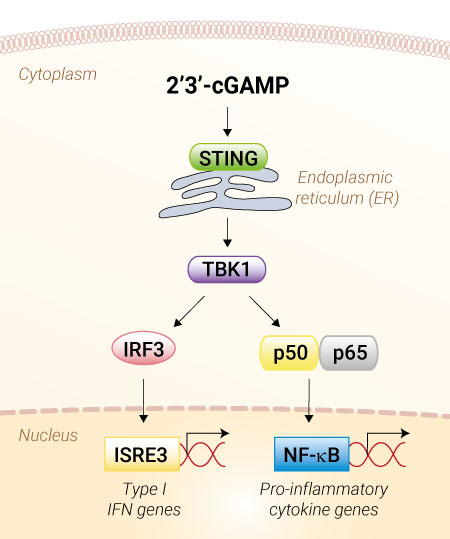2'3'-cGAMP Chemische Eigenschaften,Einsatz,Produktion Methoden
Verwenden
2′,3′-cGAMP sodium salt has been used to identify small compounds capable of binding human stimulator of interferon genes (STING). It is also used to study type I interferon response to cytosolic DNA.
Biochem/physiol Actions
2′,3′-cGAMP (cyclic [G(2′,5′)pA(3′,5′)p]) is the natural agonist for the STING (STimulator of INterferon Genes) pathway, discovered to be a pathway for antiviral innate immunity. 2′3′-cGAMP is a second messenger produced in mammalian cells by the cytosolic DNA sensor cGAS (cGAMP synthase) to activate innate immune responses by binding to STING and initiating an interferon response. The affinity of 2′3′-cGAMP for human STING is much higher than that of the bacterial 3′3′-cyclic dinucleotides (CDNs), with a Kd of 4.59 nM compared to >1 μM for bacterial 3′3′-CDNs.
Mode of action
2’3’-cGAMP (cyclic [G(2’,5’)pA(3’,5’)p]) is produced in mammalian cells by cGAS (cGAMP synthase) in response to double-stranded DNA in the cytoplasm. Similar to the canonical 3’3’-cGAMP, 2’3’-cGAMP serves as a second messenger to activate innate immune responses by binding to and activating STING. Upon activation, STING induces type I IFNs via the TANK-binding kinase 1 (TBK1)/interferon regulatory factor 3 (IRF3) pathway [1], and pro-inflammatory cytokines via the NF-κB pathway [1, 2]. Structural and functional studies have revealed that 2’3’-cGAMP is distinct from the canonical 3’3’-cGAMP produced by bacteria [3, 4]. 2'3'-cGAMP binds to STING with a much greater affinity than 3'3'-cGAMP does [1]. Interestingly, certain variants of STING are able to distinguish between noncanonical and canonical cGAMP [3].

2'3'-cGAMP Upstream-Materialien And Downstream Produkte
Upstream-Materialien
Downstream Produkte

